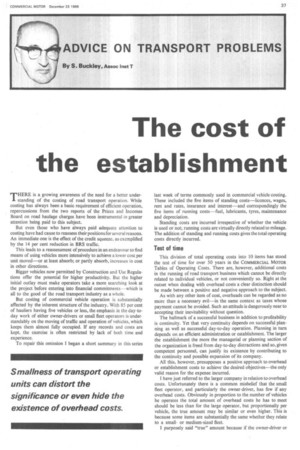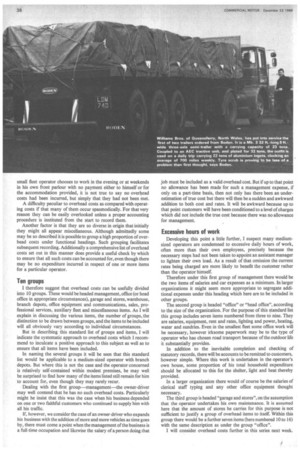The cost of the establishment
Page 39

Page 40

If you've noticed an error in this article please click here to report it so we can fix it.
THERE is a growing awareness of the need for a better under-Istanding of the costing of road transport operation. While costing has always been a basic requirement of efficient operation, repercussions from the two reports of the Prices and Incomes Board on road haulage charges have been instrumental in greater attention being paid to this subject.
But even those who have always paid adequate attention to costing have had cause to reassess their positions for several reasons. An immediate one is the effect of the credit squeeze, as exemplified by the 14 per cent reduction in BRS traffic.
This leads to a reassessment of procedure in an endeavour to find means of using vehicles more intensively to achieve a lower cost per unit moved—or at least absorb; or partly absorb, increases in cost in other directions.
Bigger vehicles now permitted by Construction and Use Regulations offer the potential for higher productivity. But the higher initial outlay must make operators take a more searching look at the project before entering into financial commitments which is all to the good of the road transport industry as a whole.
But costing of commercial vehicle operation is substantially affected by the inherent structure of the industry. With 85 per cent of hauliers having five vehicles or less, the emphasis in the day-today work of either owner-drivers or small fleet operators is understandably on the moving of traffic and operation of vehicles, which keeps them almost fully occupied. If any records and costs are kept, the exercise is often restricted by lack of both time and experience.
To repair this omission 1 began a short summary in this series last week of terms commonly used in commercial vehicle costing. These included the five items of standing costs—licences, wages, rent and rates, insurance and interest—and correspondingly the five items of running costs—fuel, lubricants, tyres, maintenance and depreciation.
Standing costs are incurred irrespective of whether the vehicle is used or not; running costs are virtually directly related to mileage. The addition of standing and running costs gives the total operating costs directly incurred.
Test of time
This division of total operating costs into 10 items has stood the test of time for over 50 years in the COMMERCIAL MOTOR Tables of Operating Costs. There are, however, additional costs in the running of road transport business which cannot be directly related to individual vehicles, or not conveniently so. Right at the outset when dealing with overhead costs a clear distinction should be made between a positive and negative approach to the subject.
As with any other item of cost, overheads can be regarded as no more than a necessary evil—in the same context as taxes whose payment cannot be avoided. Such an attitude is dangerously near to accepting their inevitability without question.
The hallmark of a successful business in addition to profitability is continuity. Yet that very continuity depends on successful planning as well as successful day-to-day operation. Planning in turn depends on an efficient administration or establishment. The larger the establishment the more the managerial or planning section of the organization is freed from day-to-day distractions and so, given competent personnel, can justify its existence by contributing to the continuity and possible expansion of its company.
All this, however, presupposes a positive approach to overhead or establishment costs to achieve the desired objectives—the only valid reason for the expense incurred.
I have just referred to the larger company in relation to overhead costs. Unfortunately there is a common misbelief that the small fleet operator, and particularly the owner-driver, has few if any overhead costs. Obviously in proportion to the number of vehicles he operates the total amount of overhead costs he has to meet should be less than for the large operator, but proportionally per vehicle, the true amount may be similar or even higher. This is because some items are substantially the same whether they relate to a smallor medium-sized fleet.
I purposely said "true" amount because if the owner-driver or small fleet operator chooses to work in the evening or at weekends in his own front parlour with no payment either to himself or for the accommodation provided, it is not true to say no overhead costs had been incurred, but simply that they had not been met.
A difficulty peculiar to overhead costs as compared with operating costs if that many of them occur spasmodically. For that very reason they can be easily overlooked unless a proper accounting procedure is instituted from the start to record them.
Another factor is that they are so diverse in origin that initially they might all appear miscellaneous. Although admittedly some may be so described it is possible to group a high proportion of overhead costs under functional headings. Such grouping facilitates subsequent recording. Additionally a comprehensive list of overhead costs set out in this manner does provide a useful check by which to ensure that all such costs can be accounted for, even though there may be no expenditure incurred in respect of one or more items for a particular operator.
Ten groups
I therefore suggest that overhead costs can be usefully divided into 10 groups. These would be headed management, office (or head office in appropriate circumstances), garage and stores, warehouse, branch depots, office equipment and communications, sales, professional services, auxiliary fleet and miscellaneous items. As I will explain in discussing the various items, the number of groups, the distinction to be drawn between groups, and the items to be included will all obviously vary according to individual circumstances.
But in describing this standard list of groups and items, I will indicate the systematic approach to overhead costs which I recommend to inculcate a positive approach to this subject as well as to ensure that all items have been included.
In naming the several groups it will be seen that this standard list would be applicable to a medium-sized operator with branch depots. But where this is not the case and the operator concerned is relatively self-contained within modest premises, he may well be surprised to find how many of the items listed still remain for him to account for, even though they may rarely recur.
Dealing with the first group—management—the owner-driver may well contend that he has no such overhead costs. Particularly might he insist that this was the case when his business depended on one or two faithful customers who continued to supply him with all his traffic.
If, however, we consider the case of an owner-driver who expands his business with the addition of more and more vehicles as time goes by, there must come a point when the management of the business is a full-time occupation and likewise the salary of a person doing that job must be included as a valid overhead cost. But if up to that point no allowance has been made for such a management expense, if only on a part-time basis, then not only has there been an underestimation of true cost but there will then be a sudden and awkward addition to both cost and rates. It will be awkward because up to that point customers will have been conditioned to a level of charges which did not include the true cost because there was no allowance for management.
Excessive hours of work
Developing this point a little further, I suspect many mediumsized operators are condemned to excessive daily hours of work, often more than their own employees, precisely because the necessary steps had not been taken to appoint an assistant manager to lighten their own load. As a result of that omission the current rates being charged are more likely to benefit the customer rather than the operator himself.
Therefore under this first group of management there would be the two items of salaries and car expenses as a minimum. In larger organizations it might seem more appropriate to segregate additional expenses under this heading which here are to be included in other groups.
The second group is headed "office" or "head office", according to the size of the organization. For the purpose of this standard list this group includes seven items numbered from three to nine. They are salaries, equipment, rent and rates, lighting and power, heating, water and sundries. Even in the smallest fleet some office work will be necessary, however irksome paperwork may be to the type of operator who has chosen road transport because of the outdoor life it substantially provides.
In addition to the inevitable completion and checking of statutory records, there will be accounts to be remitted to customers, however simple. Where this work is undertaken in the operator's own house, some proportion of his total household expenditure should be allocated to this for the shelter, light and heat thereby provided.
In a larger .organization there would of course be the salaries of clerical staff typing and any other office equipment thought necessary.
The third group is headed "garage and stores", on the assumption that the operator undertakes his own maintenance. It is assumed here that the amount of stores he carries for this purpose is not sufficient to justify a group of overhead items to itself. Within this group there would be a further seven items (here numbered 10 to 16) with the same description as under the group "office".
I will consider overhead costs further in this series next week.












































































